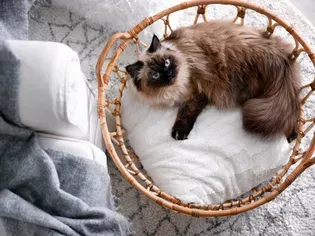Cat Language and Signals Explained
Updated on 04/26/24

Unlocking the Feline Enigma: A Comprehensive Guide to Cat Language and Signals
Cats, our enigmatic companions, possess a complex and fascinating language that allows them to communicate their emotions, needs, and intentions. While their meows and purrs are instantly recognizable, there's a wealth of subtle signals and gestures that we often miss. By understanding these feline cues, we can forge deeper bonds with our furry friends and provide them with the love and care they deserve.
Vocalizations: The Symphony of Cat Communication
* Meow: The classic cat vocalization, used to greet owners, solicit attention, or express a desire.
* Purr: A soothing, rhythmic vibration produced by cats when content, relaxed, or seeking attention.
* Chirp: A high-pitched, bird-like sound used by kittens to communicate with their mothers, or by adult cats to show excitement or interest.
* Trill: A continuous, warbling sound that can indicate happiness, excitement, or anticipation.
* Hisss: A sharp, aggressive sound used to ward off threats or express fear.
* Growl: A deep, guttural sound that serves as a warning or threat.
Body Language: Interpreting the Silent Signs
* Tail: A highly expressive indicator of mood and intent. An upright, waving tail suggests confidence; a low, tucked tail signifies fear or submission.
* Ears: Sensitive and mobile, cat ears can convey a wide range of emotions. When relaxed, ears are forward; when alert, they are erect; while flattened ears indicate fear or aggression.
* Eyes: Cats' eyes are highly expressive. Dilated pupils can indicate fear or excitement; narrowed pupils can be a sign of aggression. Slow blinking is a sign of affection or trust.
* Whiskers: Sensitive facial hairs that help cats navigate their surroundings and detect vibrations. When forward, whiskers indicate curiosity; when back, they suggest fear or submission.
* Posture: The overall body posture can reveal a cat's mood. A relaxed, open posture with limbs spread apart often indicates comfort and security; a hunched, defensive posture with limbs tucked in suggests anxiety or fear.
Contextual Cues: Unraveling the Hidden Meaning
In addition to specific signals, it's crucial to consider the context in which they occur to accurately interpret a cat's message:
* Time of Day: Cats are typically more active and communicative at certain times of the day, such as dawn and dusk.
* Environment: The surrounding environment can influence a cat's behavior and the signals they emit. A loud or unfamiliar setting can make them feel stressed or anxious.
* Past Experiences: A cat's past experiences with humans and other animals can shape their communication style. A cat with negative experiences may be more cautious or fearful.
Case Studies: Practical Applications
Understanding cat language can help us address their needs and prevent misunderstandings:
* Comforting a Scared Cat: A cat with tucked ears, dilated pupils, and a hunched posture is likely feeling scared. Provide a safe space and avoid loud noises or sudden movements.
* Encouraging Play: A cat with a raised, waving tail and chirping sounds is eager to play. Engage them with interactive toys or a laser pointer.
* Determining Hunger: A cat meowing persistently with a low-pitched, demanding tone may be hungry. Check their food bowl and ensure it's filled.
* Seeking Attention: A cat rubbing against your legs and purring is seeking affection. Give them a gentle head scratch or a cuddle.
* Warning of Aggression: A cat with flattened ears, narrowed pupils, and a hissing sound is feeling threatened or aggressive. Give them space and avoid confrontation.
Conclusion: The Gift of Feline Understanding
By understanding the nuances of cat language and signals, we can forge deeper, more meaningful bonds with our feline companions. It empowers us to provide them with the love, care, and enrichment they deserve. Embrace the challenge of deciphering their subtle cues and unlock the beauty of the feline enigma.
Explore More Pets

Cat Behavior Problems
How to Stop Aggression in Kittens

Long-Haired Cat Breeds
Siberian Cat: Breed Profile, Characteristics, & Care

Cat Behavior Problems
How to Stop Kittens From Scratching and Biting

Long-Haired Cat Breeds
Turkish Angora: Cat Breed Profile, Characteristics & Care

Basic Training
How to Socialize Your Kitten

Short-Haired Cat Breeds
Cute Pictures & Facts About Calico Cats & Kittens

Litter Box Training
Training Your Kitten to Use the Litter Box

Long-Haired Cat Breeds
10 Fun Facts About White Cats